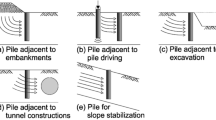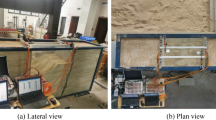Abstract
In the last few decades, there has been an increase in the popularity of helical piles in developed nations and their penetration in the construction field in developing countries. The multiple benefits of helical piles over conventional piles for smaller structures in densely populated or environmentally sensitive areas for both onshore and offshore construction have made it an obvious choice for many geotechnical engineers. Moreover, the development of high torque-generating machines has revolutionized the use of helical piles as their installation process has now become much easier and faster. Therefore, it is important to analyze the behavior of helical piles using modern and sophisticated techniques. Finite element method provides the flexibility of easy analysis of the working mechanism of helical piles by reducing cost, time, and effort and providing accurate results. Finite element analysis (FEA) incorporates more variables such as the stiffness properties, and soil-pile interactions and provides a load settlement curve, thus offering a more realistic result. In this paper, the characteristics and behavior of helical piles under different design parameters, loading directions, and soil conditions have been analyzed using finite element method in Plaxis 2D software. The parametric analysis demonstrates the influence of different design aspects and other conditions around the pile on its load-carrying capacity. The extent of influence zone formed around the pile upon loading and the deformation pattern at failure have been studied. The values of critical spacing ratio and critical embedment ratio have been determined for both cohesive and cohesionless soils.











Similar content being viewed by others
References
Adams, J. I., & Klym, T. W. (1972). A study of anchorages for transmission tower foundations. Canadian Geotechnical Journal, 9(1), 89–104. https://doi.org/10.1139/t72-007
Alwalan, M. F., & El Naggar, M. H. (2020). Finite element analysis of helical piles subjected to axial impact loading. Computers and Geotechnics, 123, 103597. https://doi.org/10.1016/j.compgeo.2020.103597
Cerato, A. B., Trujillo, V., & Shawn, A. (2017). A critical review: State of knowledge in seismic behaviour of helical piles”. DFI Journal-The Journal of the Deep Foundations Institute, 11(2017), 39–87.
Chance Technical Design Manual:2018 (Edition 4), Hubbell Power Systems, Inc.
Chen, X., Cheng, P., & Liu, Y. (2023). Large-deformation finite-element analysis of square foundations in spatially variable sediments. International Journal of Geomechanics., 23, 04023128. https://doi.org/10.1061/IJGNAI.GMENG-7406
Chen, X., Fu, Y., & Liu, Y. (2022). Random finite element analysis on uplift bearing capacity and failure mechanisms of square plate anchors in spatially variable clay. Engineering Geology, 304, 106677. https://doi.org/10.1016/j.enggeo.2022.106677
Chen, X., Han, C., Liu, J., & Hu, Y. (2021). Interpreting strength parameters of strain-softening clay from shallow to deep embedment using ball and T-bar penetrometers. Computers and Geotechnics, 138, 104331. https://doi.org/10.1016/j.compgeo.2021.104331
Chen, X., Li, D., Tang, X. S., & Liu, Y. (2021). A three-dimensional large-deformation random finite-element study of landslide runout considering spatially varying soil. Landslides. https://doi.org/10.1007/s10346-021-01699-1
Cheng, P., Guo, J., Yao, K., & Chen, X. (2023). Numerical investigation on pullout capacity of helical piles under combined loading in spatially random clay. Marine Georesources & Geotechnology, 41(10), 1118–1131. https://doi.org/10.1080/1064119X.2022.2120843
Cheng, P., Liu, Y., Li, Y. P., & Yi, J. T. (2022). A large deformation finite element analysis of uplift behaviour for helical anchor in spatially variable clay. Computers and Geotechnics, 141, 104542. https://doi.org/10.1016/j.compgeo.2021.104542
Debnath, A., & Singh, V. P. (2022). Analysis and design methods of helical piles: A critical review with emphasis on finite element method. Arabian Journal of Geosciences, 15, 1496. https://doi.org/10.1007/s12517-022-10774-3
Demir, A., & Ok, B. (2015). Uplift response of multi-plate helical anchors in cohesive soil. Geomechanics and Engineering, 8, 615–630. https://doi.org/10.12989/gae.2015.8.4.615
El Naggar, M. H., Youssef, M., & Ahmed, M. (2007). Monotonic and cyclic lateral behaviour of helical pile specialized connectors. Engineering Structures, 29, 2635–2640. https://doi.org/10.1016/j.engstruct.2007.01.018
Elsherbiny, Z., & El Naggar, M. H. (2013). Axial compressive capacity of helical piles from field tests and numerical study. Canadian Geotechnical Journal. https://doi.org/10.1139/cgj-2012-0487
Fahmy, A., & El Naggar, M. H. (2017). Cyclic lateral performance of helical tapered piles in silty sand. DFI Journal - The Journal of the Deep Foundations Institute. https://doi.org/10.1080/19375247.2017.1286428
George, B. E., Banerjee, S., & Gandhi, S. R. (2017). Numerical analysis of helical piles in cohesionless soil. International Journal of Geotechnical Engineering. https://doi.org/10.1080/19386362.2017.1419912
HAI Engineering Manual:2014 (EDM Rev 02), Helical Anchors Inc.
International Building Code. (2009). International Code Council, Inc., Publications, 4051 West Flossmoor Road, Country Club Hills, IL 60478.
Khan, U., & Siddiqua, S. (2018). Study of compressive loading capacities of helical piles using torque method and induced settlements. Environmental Earth Sciences. https://doi.org/10.1007/s12665-017-7199-z
Liu, H., Zubeck, H., & Schubert, D. (2007). Finite-element analysis of helical piers in frozen ground. Journal of Cold Regions Engineering, 21, 92–106. https://doi.org/10.1061/(ASCE)0887-381X(2007)21:3(92)
Liu, Y., Chen, X., & Hu, M. (2023). Three-dimensional large deformation modeling of landslides in spatially variable and strain-softening soils subjected to seismic loads. Canadian Geotechnical Journal, 60(4), 426–437. https://doi.org/10.1139/cgj-2022-0106
Livneh, B., & El Naggar, M. H. (2008). Axial testing and numerical modelling of square shaft helical piles under compressive and tensile loading. Canadian Geotechnical Journal, 45, 1142–1155.
Merifield, R. S. (2011). Ultimate uplift capacity of multiplate helical type anchors in clay. Journal of Geotechnical and Geoenvironmental Engineering., 137, 704–716. https://doi.org/10.1061/(ASCE)GT.1943-5606.0000478
Narasimha, R. S., & Prasad, Y. V. S. N. (1993). Estimation of uplift capacity of helical anchors in clays. Journal of Geotechnical Engineering, 119(2), 352–357.
Papadopoulou, K., Saroglou, H., & Papadopoulos, V. (2014). Finite element analyses and experimental investigation of helical micropiles. Geotechnical and Geological Engineering. https://doi.org/10.1007/s10706-014-9771-6
Potyondy, J. G. (1961). Skin friction between various soils and construction materials. Geotechnique, 11(1961), 339–353.
Sakr, M. (2009). Performance of helical piles in oil sand. Canadian Geotechnical Journal, 46, 1046–1061. https://doi.org/10.1139/T09-044
Spagnoli, G., & Gavin, K. (2015). Helical piles as a novel foundation system for offshore piled facilities. https://doi.org/10.2118/177604-MS
Spagnoli, G., & Tsuha, C. H. C. (2020). A review on the behavior of helical piles as a potential offshore foundation system. Marine Georesources & Geotechnology, 38(2020), 1013–1036.
Trofimenkov, J. G., & Maruipolshii, L. G. (1965). Screw piles used for mast and tower foundations. In Proceedings of the 6th international conference on soil mechanics and foundation engineering, vol. 2, pp. 328–332.
Funding
This research did not receive any specific grant from funding agencies in the public, commercial, or not-for-profit sectors.
Author information
Authors and Affiliations
Contributions
AD: methodology, software analysis, validation, writing original draft. VPS: visualization, resources, supervision. RKS: conceptualization, review and editing.
Corresponding author
Ethics declarations
Conflict of interest
No potential conflict of interest was reported by the authors. The authors have no relevant financial or non-financial interests to disclose.
Additional information
Publisher's Note
Springer Nature remains neutral with regard to jurisdictional claims in published maps and institutional affiliations.
Rights and permissions
Springer Nature or its licensor (e.g. a society or other partner) holds exclusive rights to this article under a publishing agreement with the author(s) or other rightsholder(s); author self-archiving of the accepted manuscript version of this article is solely governed by the terms of such publishing agreement and applicable law.
About this article
Cite this article
Debnath, A., Singh, V.P. & Srivastava, R.K. Analysis of the Static Axial Capacity of Helical Piles Using Finite Element Method. Int J Steel Struct 23, 1602–1616 (2023). https://doi.org/10.1007/s13296-023-00791-7
Received:
Accepted:
Published:
Issue Date:
DOI: https://doi.org/10.1007/s13296-023-00791-7




